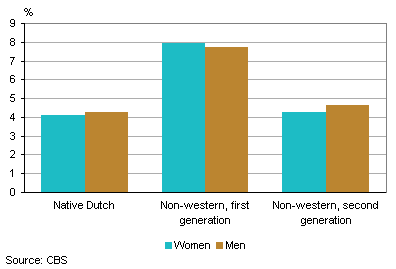Use of anti-diabetics by ethnic background

Proportionally, more first-generation people with a non-western background than native Dutch take anti-diabetics. The most recent figures published by Statistics Netherlands show that, with respect to the second-generation, the difference has disappeared altogether. The figures also show that more than seven in every ten native Dutch were prescribed at least one medicine in 2009.
From 8 percent in the first generation to 4 percent in second generation
More people with a non-western background than native Dutch were prescribed anti-diabetics at least once a year, but this only applies to the first generation, of whom nearly 8 percent took a anti-diabetics in 2009. The proportion of people taking anti-diabetics in the second generation - more than 4 percent - is the same as in the native Dutch population. With respect to other groups of medicines, people with a foreign background belonging to the first generation often do not take as many medicines as native Dutch. Differences in age distribution between the two population categories have been taken into account.
Persons taking anti-diabetics, standardised by age, 2009

Vast majority take at least one medicine
In 2009 62 percent of men and 78 percent of women were prescribed at least one medication included in the compulsory basic health insurance package, mostly antibiotics; 17 percent were prescribed medication against rheumatism or inflammations of the skeletal muscle system and 14 percent antacids.
Gerard Verweij and Patty Elferink